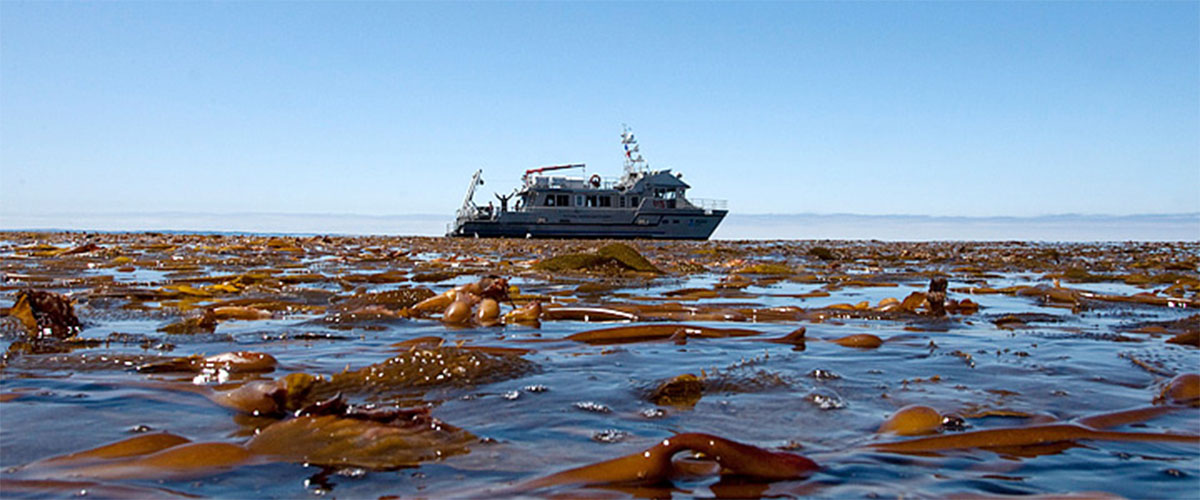Impacts on Kelp Forests

Numerous natural impacts as well as human activities, affect kelp forest environments.
The factors influencing kelp forest stability are diverse: kelp harvesting; grazing by fishes, sea urchins, and crustaceans; plant competition; storms; El Niño events; sedimentation; and pollution. By most accounts, because of its spectacular growth rates, kelp recovers quickly from physical disturbances such as storms that might uproot the fragile plants. However, as in all natural environments, the health is proportional to the number of adverse conditions to which it is exposed.
Commercial kelp harvesting is potentially the greatest threat to long-term kelp stability nationwide. It has supported a multitude of industries over the past century. From the extractions of kelp during World War I for potash to the modern use of kelp for food additives and pharmaceutical products, kelp has proven to be a dynamic and highly demanded product.
Kelp harvesting during World War I peaked in 1919 when 400,000 wet tons were used to make potash for gunpowder and fertilizer. In the 1930s the food, pharmaceutical, and scientific communities began extracting algin, a thickening, stabilizing, suspending, and gelling agent. Algin is an additive used in a wide variety of dairy products, frozen foods, cakes, puddings, salad dressings, shampoos, and toothpastes. It smoothes and thickens ice cream, emulsifies salad dressing, and keeps pigments uniformly mixed in paints and cosmetics. Additionally, some mariculture farms hand-harvest kelp to feed abalone. In the 1980's alone, kelp harvesting supported an industry worth more than $40 million a year, and in 1993, more than 4,700 wet tons of kelp were extracted from the Monterey Bay National Marine Sanctuary.
Large numbers of opaleye or halfmoon fishes can damage kelp forests, particularly when the kelp is exposed to unfavorable growing conditions. As in all ecosystems, a balance exists in this complex environment, and the predators such as sea otters generally contain sea urchins or grazing fishes enough to limit the damage by grazing. This balance of power is usurped when the predatory populations go into decline, as exemplified by the huge explosion of sea urchins when otter populations suffer from oil spills or disease.
High energy storms or swells can uproot entire plants and break away fronds. Characterized by severe storms and warm water, El Niño Southern Oscillation Events, often devastate kelp forests. The strong swell activity, winter storms, and warm weather associated with the 1997-1998 El Niño were the primary sources of kelp mortality on the California coast in 1998. Kelp forests south of Point Coneception sustained up to 100 percent mortality in some regions, although comparable habitats north of that region "were relatively unaffected." Researchers attribute the discrepancy between southern and central California to ocean temperature gradients; the El Niño brought unusually high ocean temperatures to southern California where the heat degraded the health of the giant kelp forests. The combined warm water temperature and strong wave energy caused high mortality in the south. Central California bull kelp forests remained in cooler waters and thus in better condition when the winter swells hit, and a much greater percent survived.
Non-point and point source pollution including sewage, industrial disposal, and coastal runoff might contribute to kelp forest degradation. For instance, high sedimentation from coastal run-off may bury new plant shoots.
Similarly, kelp may experience reduced growth rates and reproductive success in more toxic waters and sediments. Studies on microscopic stages of kelp suggest that kelp is sensitive to sewage, industrial waste discharges, and other causes of poor water and sediment quality.
Kelp monitoring projects actively continue in the four sanctuaries. With ongoing surveys of kelp extent, physical oceanic conditions, and associated biota, the researchers will gain a more complete understanding of natural and antropogenic impacts on kelp forests.

